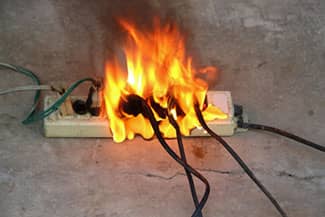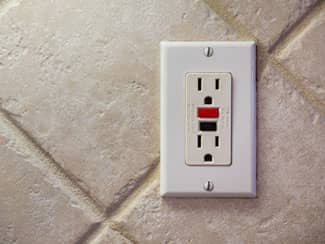INSPECT ELECTRICAL SYSTEMS/TEST GROUND FAULT INTERRUPTER OUTLETS
Thanks to Benjamin Franklin’s discovery of electricity and Thomas Edison’s invention of the lightbulb, civilization no longer functions by candlelight. We can cook a meal in minutes with a zap of the microwave and click on the TV instead of watching awkward puppet shows for entertainment.
However the convenience of electricity comes with its fair share of responsibility. An area that tends to be overlooked when it comes to maintaining our homes is the usage, condition and safety of our electrical systems.
According to FEMA’s December 2018 report, from 2014 to 2016, an estimated 24,000 residential building electrical fires were reported by U.S. fire departments annually. These fires caused an estimated 310 deaths, 850 injuries and $871 million in property loss. Electrical fires accounted for six percent of all residential building fires.
“In many cases, these fires could have been prevented with a biennial electrical systems check-up,” said Noel Pena, electrician, Fox Valley Electric, a Rosie-Certified Partner.
In addition to the check-up, make sure you have smoke alarms installed on every level of your home, inside of every bedroom and outside of each sleeping area.
It is important to know the age of your electrical system. Hire a licensed electrician to do an inspection every two years. The date of the last inspection should be on the inside of the circuit breaker’s panel. If a date can’t be found, go by the age of the house.
Pena noted that before testing or repairing wiring, “Shut off electricity to the room by throwing that room’s breaker off in the electric panel. If the breakers are not labeled, label them now. Test the wires with a voltage detector before you start rewiring anything.”

The consumer resource, Safe Bee by UL (Underwriters Laboratories), provides a comprehensive list of the proper uses of electrical equipment and warning signs.
The Warning Signs
- Malfunctioning switches and outlets. If switches or outlets don’t work or are broken or prone to tripping the circuit breaker, something is wrong with the wiring.
- Dimming or flickering lights. Because light fixtures typically draw only a small amount of power, dimming or flickering is rarely caused by a problem with the fixture itself. More likely the issue is with major appliances or space heaters that are wired to the same circuit and use a lot of energy.
- Hot or smoking outlets, switch plates and circuit breaker box. Outlets should never become hot. The switch plate may be slightly warm, but if the outlet is hot, turn off what is plugged in and try it in another outlet. If the outlet grows hot without anything plugged in, it may be wired incorrectly. If an outlet or breaker box is smoking or extremely hot to the touch, call the fire department immediately.
- Sparking. Not a good sign. If the spark is coming from a breaker panel, fuse box or outlet, go to the breaker box immediately and turn off all the breakers. Then call an electrician who can safely diagnose the issues and turn them back on. A sparking appliance may mean that the fixture itself is damaged. Turn the breaker to the appliance off. A reputable appliance repairperson should be able to remedy that by testing the appliance and the outlet that powers it. If the appliance is new, find out if it can be repaired under the warranty.
- Funny odors. A new appliance may produce an odor the first few times it’s powered up. If you detect an odd smell coming from an outlet, turn off and unplug anything connected to it. Don’t use it again until a qualified, licensed electrician checks it out. If your fuse box or breaker panel has a weird odor, call an electrician right away.
- Buzzing outlets. Outlets should not emit any sounds. Loose prongs, outlets or fraying wire can cause the current to jump, thus producing a buzzing sound. If you’re sure a sound is coming from an outlet, stop using it and call an electrician.
Proper Uses of Electronics and Wiring

- Plug in one heat-producing appliance at a time. A coffee maker, space heater or microwave should be plugged directly into a wall outlet one at a time. This will help prevent the circuit from overloading.
- Do not overload power strips or outlets. Instead of power strips, choose point-of-protection surge protectors with the UL Mark. These contain a special device that redirects a voltage surge. Use one for all major electronics and appliances, which will help protect your devices from power surges.
- NOTE: Many are one time use for major surges. For total protection invest in a whole house surge protector.
- Extension cord usage. Choose a UL Listed extension cord rated to handle the wattage. Use only outdoor-rated extension cords outside. Never use extension cords for a major appliance, even temporarily, as they can easily overheat and start a fire. Running an extension cord creates additional points where cords can kink, short out or get pinched, leading to tripped breakers, damaged outlets or even a fire. Use extension cords sparingly and for short periods of time. If you need more outlets, have a licensed electrician install them.
- Use ground-fault circuit interrupters (GFCIs). Water is an excellent conductor of electricity. Kitchens and bathrooms require special shock-resistant outlets called ground-fault circuit interrupters (GFCIs). GFCIs typically have two small buttons at the center. If outlets in your kitchen and bathroom do not have the buttons, swap them out with GFCIs to add an extra layer of shock protection around water. GFCIs reduce the likelihood of shock, because they shut off electricity if it detects an electric surge. Add GFCIs to older homes to prevent in-home electrocutions. Test once a month.
- Install arc-fault circuit interrupters (AFCIs). These shut off electricity when a dangerous condition occurs, such as loose connections, preventing wires from overheating and causing a fire. Test once a month.
- Unplug small appliances when not in use. Left unattended, plugged-in appliances may create an unnecessary fire risk.
- Use recommended wattage light bulbs in lamps or fixtures. Using a bulb with too high of a wattage may overheat the light fixture or wiring, causing a fire.
- Inspect all electrical cords. Replace cracked, damaged and loose electrical cords. Don’t try to repair them.
- Avoid putting cords where they can be damaged or pinched. Cords placed under carpet, rugs, windows or doors can be get pinched and cause the wires to become damaged, thus risking fire and/or electrocution. Fully unravel all appliance cords when in use as wrapped cords trap heat and increase fire risk.
Take time to go through your house with this checklist twice a year to ensure that your home’s electrical system is in good and safe working condition. Don’t become a statistic.
Premium subscribers to HomeZada can schedule reminders in our home maintenance app.
Home Maintenance To-Do | #ElectricalTest
FOX VALLEY ELECTRIC
Since 2007, Fox Valley Electric has provided quality electrical construction, service and maintenance to their customers in the Phoenix metropolitan area. Their electricians can install anything from new security lighting to a whole-home generator that will keep appliances working during a power outage.

###















